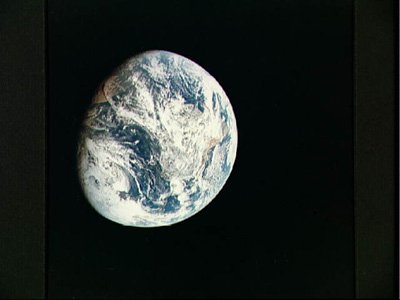New eye in the sky charts Earth's green breathing
A striking view from the Apollo 8 spacecraft showing nearly the entire Western Hemisphere, from the mouth of the St. Lawrence River, including nearby Newfoundland, to Tierra del Fuego at the southern tip of South America. Central America is clearly outlined. Nearly all of South America is covered by clouds except the high Andes mountain chain along the west coast.
NASA Photo ID: AS08-16-2593
by Ralph Kahn, June 1998
If global warming had a logo, it would be a lightning bolt, reaching ever upward to the right, a graphic reminder of the way carbon dioxide in our atmosphere is increasing. Though we cannot smell or taste it, this "greenhouse gas" acts as a blanket, helping to warm Earth's surface by trapping heat. The increase is linked to the growing amounts of coal, oil and gasoline we burn.
Atmospheric carbon dioxide has increased by more than 23% since the start of the Industrial Revolution, about 13% since 1958 alone. These rates are unprecedented in an environmental record that stretches back 160,000 years.
But when the calendar turns to May, the graph temporarily reverses direction, hinting that fossil fuel combustion is not the only factor affecting our atmosphere's inventory of carbon. Every spring, Earth takes a deep breath of carbon dioxide. Trees bud, grasses sprout and flowers blossom over vast expanses of land throughout the Northern Hemisphere. Even in Los Angeles, which is usually arid, the hills receive their annual cover of green.
And across the North Atlantic, the North Pacific, the Barents Sea and Hudson's Bay, single-celled floating plants proliferate just below the water's surface. Both terrestrial and aquatic vegetation begin their work in the warm and sunny months, removing carbon dioxide gas from the atmosphere and transforming it into solid organic tissue. For a season, atmospheric carbon dioxide is gradually depleted by 1% to 2% over the entire planet.
This year, a new satellite instrument is watching Earth's vernal blooming from space. The instrument's acronym, SeaWiFS, pronounced "Sea-Whiffs," stands for sea-viewing wide field-of-view sensor. It is an orbiting camera that looks at the color of chlorophyll, the green chemical plants use to harvest sunlight and power the transformation of carbon dioxide.
SeaWiFS measurements tell when and where plants are growing; from this scientists can estimate how much carbon they are removing from the atmosphere. Only part of the carbon dioxide lost to plants in spring will be returned to the atmosphere by autumn. And as environmental conditions change, plants may absorb more or less carbon, reducing or enhancing the annual atmospheric buildup. SeaWiFS is giving a global picture of where these changes are taking place. The latest images reveal immense algae blooms in coastal waters, fed by nutrients that are washed off the land and stirred up from the deep ocean.
For us, and for most animals, the spring bloom is more than a symbolic rebirth. We are made of carbon--about 18% by weight. Long chains of carbon atoms linked together form the backbones of proteins, fats and carbohydrates, mainstays of our diet.
As plants remove carbon dioxide from the atmosphere, they create the vegetable matter that will feed us and those upon whom we prey. But the organic carbon we eat is merely on loan from the environment. Our metabolism breaks carbon chains apart. When we exhale, we undo the work of plants, returning to the air molecules with a single carbon atom attached to two oxygens--carbon dioxide.
When autumn comes to the north, the seasonal vegetation will die back. Bacteria and other microscopic animals will digest most of the scraps, releasing carbon dioxide and completing the annual cycle of carbon. Although it will be spring in the Southern Hemisphere, seasonal plant growth there is less dramatic; land is scarce on the southern half of the planet, offering less coastline to force terrestrial and deep-sea nutrients together with warm, sunlit surface water
By November, the global warming logo will resume its upward trend. But each year the line reaches higher than the previous year's mark. As we burn coal and other fossil fuels, we are undoing the work of ancient plants, breaking down preserved organic matter and releasing its carbon along with the carbon from the year's seasonal growth.
SeaWiFS, which was launched in August, is scheduled to spend the next five years keeping an eye on Earth's biosphere. The satellite will observe how aquatic plant growth is affected by changing ocean temperatures, climate phenomena such as El Niño, coastal water pollution, and year-to-year increases in atmospheric carbon dioxide itself.
Will changes in plant growth do anything to mitigate the rise in carbon dioxide? As we watch the global warming logo take its springtime dip, it is our turn to hold our breath.
The SeaWiFS web site is: http://seawifs.gsfc.nasa.gov/SEAWIFS.html.
Ralph Kahn is a Jet Propulsion Laboratory research scientist and participant in the EOS project who writes about earth and space science issues.
Copyright © 1998 by R. Kahn. All rights reserved.
This article first appeared in the Los Angeles Times, Thursday, June 4, 1998.
